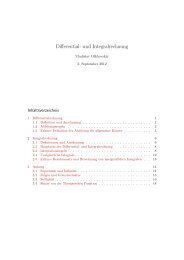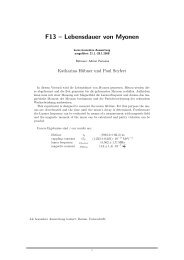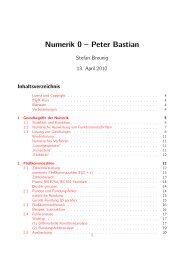Extrasolar Moons as Gravitational Microlenses Christine Liebig
Extrasolar Moons as Gravitational Microlenses Christine Liebig
Extrasolar Moons as Gravitational Microlenses Christine Liebig
Create successful ePaper yourself
Turn your PDF publications into a flip-book with our unique Google optimized e-Paper software.
CHAPTER 4. CHOICE OF SCENARIOS 39<br />
whole lensing system. All other m<strong>as</strong>ses enter the equation in units of the primary<br />
m<strong>as</strong>s. The Einstein radius, see equation (2.3), is the natural me<strong>as</strong>ure for angular<br />
separations in our system and is proportional to the square root of this m<strong>as</strong>s. A<br />
given magnification pattern is produced with a unit m<strong>as</strong>s and scales with the m<strong>as</strong>s<br />
of the primary lens (while lengths scale with √ MStar <strong>as</strong> the Einstein radius).<br />
It is not at all straightforward to obtain the m<strong>as</strong>s of the lensing star through<br />
microlensing observations. It h<strong>as</strong> been achieved in individual c<strong>as</strong>es through a combined<br />
me<strong>as</strong>urement of parallax and the Einstein radius θE , summarised in Gould<br />
(2008b), but lens m<strong>as</strong>s determination is not an e<strong>as</strong>y t<strong>as</strong>k. For our simulations we<br />
rely on statistic drawn from Galactic models (figure 4.8). We <strong>as</strong>sume our primary<br />
m<strong>as</strong>s to be an M-dwarf star with a m<strong>as</strong>s of MStar = 0.3M⊙, because that is the<br />
most abundant type of star to be found toward the Galactic bulge. We derive the<br />
corresponding Einstein radius θE(DS, DL, MStar) = 0.32 milliarcseconds.<br />
4.2.4 Source size<br />
−∆mag<br />
3<br />
2<br />
1<br />
0<br />
Triple Lens Binary Lens Figure 4.9: For this pair of<br />
light curves a source size of one<br />
solar radius h<strong>as</strong> been chosen:<br />
Rsource = R⊙. The triple-lens<br />
0 0.1 0.2 0.3 0.4<br />
t/tE<br />
0.5 0.6 0.7<br />
light curve is obtained from the<br />
magnification pattern in figure<br />
4.10. There is a noticeable difference<br />
between the triple-lens light<br />
curve and the binary-lens light<br />
curve and the planetary causticcrossing<br />
features are pronounced<br />
in both.<br />
The source size influences the “time resolution” of a light curve. For every light<br />
curve point we have to integrate over the projected size of the source. Finer caustic<br />
structures can e<strong>as</strong>ily get lost in this process. Unfortunately, for our source star<br />
<strong>as</strong>sumptions we have to take into account not only the abundance function of the<br />
Galactic stellar population, but also the luminosity of a given stellar type. M-dwarfs<br />
are in all probability too faint to be seen at a large distance by our telescopes – even<br />
if they are lensed and magnified. Therefore giant stars are more probable <strong>as</strong> source<br />
stars in our gravitational lensing setting. But the finite source size constitutes<br />
a serious limitation to the discovery of extr<strong>as</strong>olar moons. In fact, Han and Han<br />
(2002) stated that detecting satellite signals in the lensing light curves will be close<br />
to impossible, because the signals are seriously smeared out by the severe finitesource<br />
effect. They tested various source sizes (and planet-moon separations) for an<br />
Earth-m<strong>as</strong>s planet with a Moon-m<strong>as</strong>s satellite. They find that even for a K0-type<br />
source star any light curve modifications caused by the moon are w<strong>as</strong>hed out. Those










